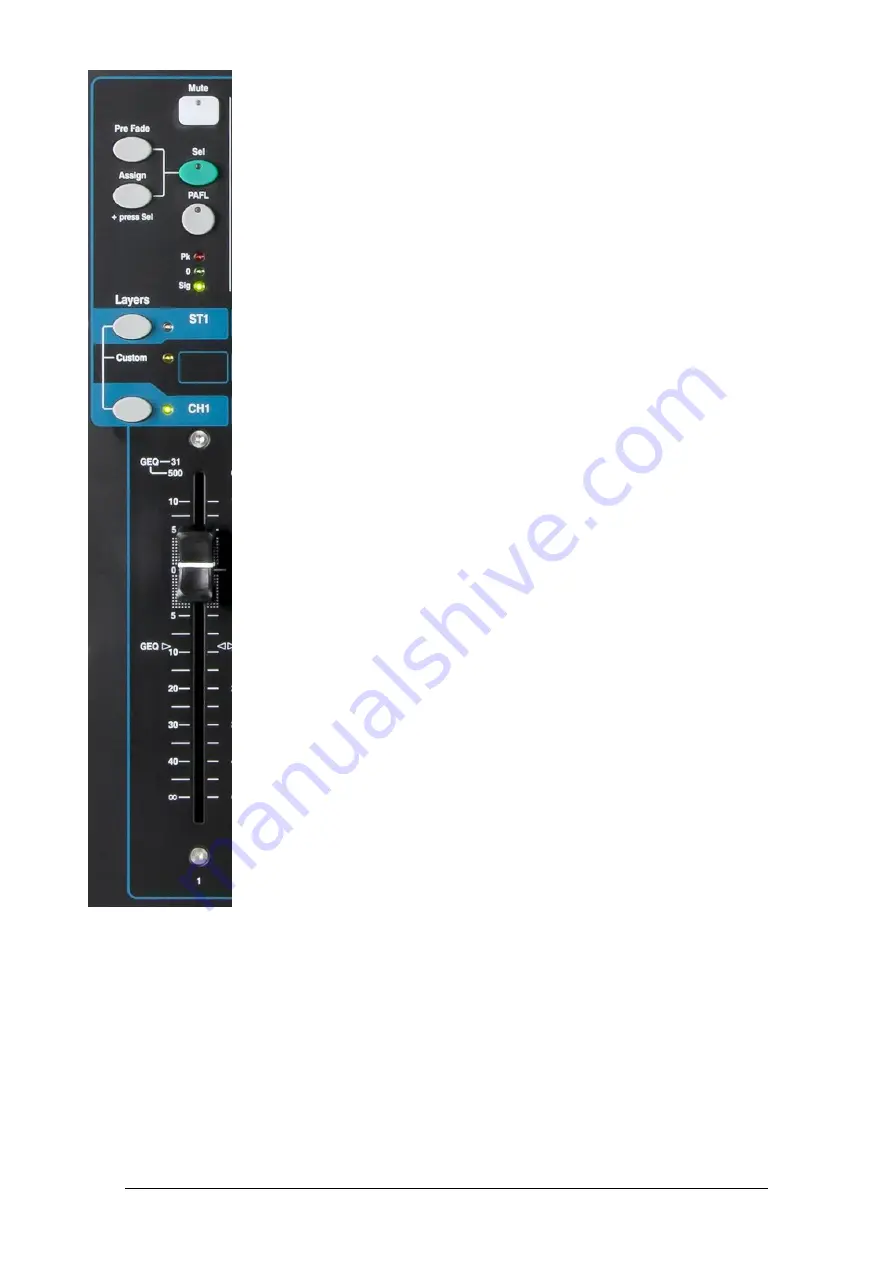
Qu Mixer Reference Guide
22
AP9372 iss.9
Mute key
– Press to turn off the channel audio signal. This affects the send to
all mixes including LR, groups, effects and stage monitors. The key lights red when
muted. It flashes when muted by a Mute or DCA Group master.
Sel key (select)
– Press to access the Channel Processing. Parameters can
be adjusted using the SuperStrip controls. The touch screen will display the
settings and provide additional controls if either the
Processing
or
Routing
screen
is active. The Sel key is also used for:
Assign mix routing – Hold down the ‘Assign’ key and press Sel keys to
assign channels to the mix currently selected in the Master Strip. The Sel
keys light green to show channels assigned to the selected mix.
Assign Pre/Post fade sends – Hold down the ‘Pre Fade’ key and press Sel
keys to toggle channel sends pre or post fader for the mix currently selected
in the Master Strip. The Sel keys light green to show channels set pre-fade.
Copy channel processing – Hold down the Copy key and press a channel
Sel key to copy its processing settings. Then hold down the Paste key and
press one or more Sel keys to instantly paste those settings to other
channels.
Reset channel processing – Hold down the Reset key and press a channel
Sel key to instantly reset all it’s processing to factory default.
Reset Graphic EQ band – Press Sel to reset the associated GEQ frequency
band to 0dB while in GEQ Flip mode.
PAFL key
– Press to listen to a channel using headphones and check its level
on the main meters. The meter PAFL indicator lights. Press PAFL again to turn it
off. A SoftKey can be assigned to clear all active PAFL selections. Options are
available in the
Setup / Audio / PAFL
screen to choose how you want PAFL to
work:
Additive mode – Pressing a PAFL key automatically cancels any previous
selection. Turn Additive on to PAFL more than one channel at a time.
Sel follow PAFL – Link the Sel switch so that pressing PAFL automatically
selects the processing for that channel.
LR to PAFL – Routes the main LR mix to the monitor when there is no PAFL
selected.
Output AFL – This option sets the mix strip PAFL keys to monitor AFL (after-
fade listen). With this option turned off these keys monitor PFL (pre-fade
listen). The default is AFL so that you can check mixes after the master fader.
Input AFL – This option sets the input strip PAFL keys to monitor AFL (after-
fade listen). With this option turned off these keys monitor PFL (pre-fade
listen). PFL is the usual setting for inputs so that you can check and set their
gain before you bring up the faders.
Channel meter
– The strip meters let you keep an eye on signal levels while
you are mixing. These display channel level before the fader and mute control:
Pk – Lights red to warn that the signal is too hot and gain or trim should be
reduced. It turns on 3dB before clipping to warn you before audible
distortion. Pk senses the signal at several points within the channel.
0 – Lights when the signal reaches nominal 0dBu allowing a healthy 18dB
headroom. This is the normal level for mixing.
Sig – Lights to show signal presence. It turns on at -26dBu.
Fader
– Controls the level of the input channel, FX or mix master assigned to it.
This can be the main channel fader or a send to an effect or mix depending on
which Mix Select key is active in the Master Strip.
The faders can also control the Graphic EQ frequency bands while in GEQ Flip
mode. The range of frequencies accessed by the faders is highlighted in the touch
screen and labelled at the top of the faders. The centre 0dB flat position is marked
on the fader scale.






























